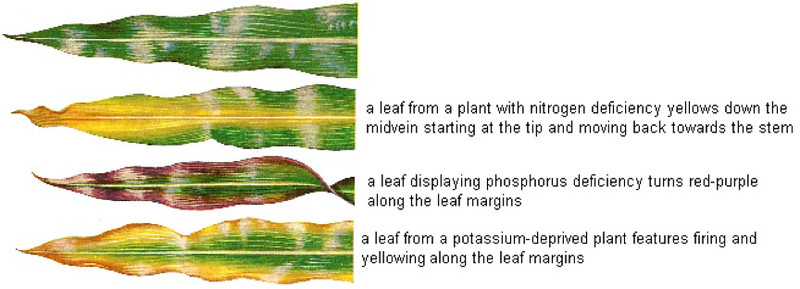Learn: Plant Nutrients & the significance of nutrient mobility
Nutrients
Macronutrients: used in large quantities by the plant
- Structural nutrients: C, H, O
- Primary nutrients: N, P, K
- Secondary nutrients: Ca, Mg, S
Micronutrients: used in small quantities by the plant
- Fe, B, Cu, Cl, Mn, Mo, Zn, Co, Ni
Plants require eighteen elements found in nature to properly grow and develop. Some of these elements are utilized within the physical plant structure, namely carbon (C), hydrogen (H), and oxygen (O). These elements, obtained from the air (CO2) and water (H2O), are the basis for carbohydrates such as sugars and starch, which provide the strength of cell walls, stems, and leaves, and are also sources of energy for the plant and organisms that consume the plant.
Elements used in large quantities by the plant are termed macronutrients, which can be further defined as primary or secondary. The primary nutrients include nitrogen (N), phosphorus (P), and potassium (K). These elements contribute to plant nutrient content, function of plant enzymes and biochemical processes, and integrity of plant cells. Deficiency of these nutrients contributes to reduced plant growth, health, and yield; thus they are the three most important nutrients supplied by fertilizers. The secondary nutrients include calcium (Ca), magnesium (Mg), and sulfur (S).
The final essential elements are used in small quantities by the plant, but nevertheless are necessary for plant survival. These micronutrients include iron (Fe), boron (B), copper (Cu), chlorine (Cl), Manganese (Mn), molybdenum (Mo), zinc (Zn), cobalt (Co), and nickel (Ni).
- Phosphorus excess can lead to reduced zinc uptake
- Potassium excess has been found to reduce magnesium uptake and vice versa
- Calcium excess can cause boron or magnesium deficiencies
LIST CHEMICAL UPTAKE FORMS FOR EACH MACRONUTRIENT
- Nitrogen: nitrate (NO3-) and ammonium (NH4+).
- Phosphorus: phosphate (HPO42- and H2PO4-).
- Potassium: K+.
- Calcium: Ca2+.
- Magnesium: Mg2+.
- Sulfur: sulfate (SO4-)
HOW NUTRIENT DEMANDS CHANGE AT DIFFERENT PLANT GROWTH STAGES
In general, plant nutrient needs start low while the plants are young and small, increases rapidly through vegetative growth, and then decreases again around the time of reproductive development. While absolute nutrient requirements may be low for young plants, they often require or benefit from high levels in the soil around them. The nutrient status of the early seedling will affect the overall plant development and yield. Plants entering the reproductive stages have high nutrient requirements, but many of these are satisfied by redistributing nutrients from the vegetative parts.

Mobility
The mobility of a nutrient in the plant determines where deficiency symptoms show up.
Nutrients that are mobile in the plant will move to new growth areas, so the deficiency symptoms will first show up in older leaves.
Nutrients that are not mobile/immobile in the plant will not move to new growth areas, so deficiency symptoms will first show up in the new growth.
Nutrients also have variable degrees of mobility in the plant, which influences where deficiency symptoms appear. For nutrients like nitrogen, phosphorus, and potassium, which are mobile in the plant, deficiency symptoms will appear in older leaves. As new leaves develop, they will take the nutrients from the old leaves and use them to grow. The old leaves are then left without enough nutrients, and display the symptoms. The opposite is true of immobile nutrients like calcium; the new leaves will have symptoms first because they cannot take nutrients from the old leaves, and there is not enough in the soil for their needs.
The table below lists the essential elements, their status as macro- or micronutrients, their uptake forms, and their plant mobility.
| Nutrient | Macro/micro | Uptake form | Mobility in Plant | Mobility in Soil |
| Carbon | Macro | CO2, H2CO3 | ||
| Hydrogen | Macro | H+, OH-, H2O | ||
| Oxygen | Macro | O2 | ||
| Nitrogen | Macro | NO3-, NH4+ | Mobile | Mobile as NO3-, immobile as NH4+ |
| Phosphorus | Macro | HPO42-, H2PO4- | Somewhat mobile | Immobile |
| Potassium | Macro | K+ | Very mobile | Somewhat mobile |
| Calcium | Macro | Ca2+ | Immobile | Somewhat mobile |
| Magnesium | Macro | Mg2+ | Somewhat mobile | Immobile |
| Sulfur | Macro | SO4- | Mobile | Mobile |
| Boron | Micro | H3BO3, BO3- | Immobile | Very mobile |
| Copper | Micro | Cu2+ | Immobile | Immobile |
| Iron | Micro | Fe2+, Fe3+ | Immobile | Immobile |
| Manganese | Micro | Mn2+ | Immobile | Mobile |
| Zinc | Micro | Zn2+ | Immobile | Immobile |
| Molybdenum | Micro | MoO4- | Immobile | Somewhat mobile |
| Chlorine | Micro | Cl- | Mobile | Mobile |
| Cobalt | Micro | Co2+ | Immobile | Somewhat mobile |
| Nickel | Micro | Ni2+ | Mobile | Somewhat mobile |
Recent Posts
-
Important Notice to Our Customers: We Do Not Sell on Amazon, eBay, Walmart, or Etsy
Important Notice to Our Customers Green Leaf Aquariums (GLA) products are sold exclusively through o
-
Nature Aquarium Aquascape / Hardscape Inspriation, Layouts & Ideas - Low, Moderate & Higher Maintenance Tank Scapes
Nature Aquarium Aquascape Planting & Layout Ideas1. Low Maintenance Aquascape: "The Tranquil For
